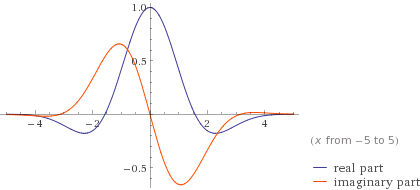Gabor wavelets are wavelets invented by Dennis Gabor using complex functions constructed to serve as a basis for Fourier transforms in information theory applications. They are very similar to Morlet wavelets. They are also closely related to Gabor filters. The important property of the wavelet is that it minimizes the product of its standard deviations in the time and frequency domain (given by the variances defined below). Put another way, the uncertainty in information carried by this wavelet is minimized. However they have the downside of being non-orthogonal, so efficient decomposition into the basis is difficult. Since their inception, various applications have appeared, from image processing to analyzing neurons in the human visual system.[1][2]
YouTube Encyclopedic
-
1/3Views:3 3281 07111 719
-
Final Year Projects | Gabor Wavelet based Blood Vessel Segmentation in Retinal images using Kernel
-
Segmentation Using the 2-D Gabor Wavelet and Supervised Classification
-
CIS531: Gabor Filters and Wavelets on Images
Transcription
Minimal uncertainty property
The motivation for Gabor wavelets comes from finding some function which minimizes its standard deviation in the time and frequency domains. More formally, the variance in the position domain is:
where is the complex conjugate of and is the arithmetic mean, defined as:
The variance in the wave number domain is:
Where is the arithmetic mean of the Fourier Transform of , :
With these defined, the uncertainty is written as:
This quantity has been shown to have a lower bound of . The quantum mechanics view is to interpret as the uncertainty in position and as uncertainty in momentum. A function that has the lowest theoretically possible uncertainty bound is the Gabor Wavelet.[3]
Equation
The equation of a 1-D Gabor wavelet is a Gaussian modulated by a complex exponential, described as follows:[3]
As opposed to other functions commonly used as bases in Fourier Transforms such as and , Gabor wavelets have the property that they are localized, meaning that as the distance from the center increases, the value of the function becomes exponentially suppressed. controls the rate of this exponential drop-off and controls the rate of modulation.
It is also worth noting the Fourier transform of a Gabor wavelet, which is also a Gabor wavelet:
An example wavelet is given here:

Time-causal analogue of the Gabor wavelet
When processing temporal signals, data from the future cannot be accessed, which leads to problems if attempting to use Gabor functions for processing real-time signals that depend upon the temporal dimension. A time-causal analogue of the Gabor filter has been developed in [4] based on replacing the Gaussian kernel in the Gabor function with a time-causal and time-recursive smoothing kernel referred to as the time-causal limit kernel. In this way, time-frequency analysis based on the resulting complex-valued extension of the time-causal limit kernel makes it possible to capture essentially similar transformations of a temporal signal as the Gabor wavelets can handle, and corresponding to the Heisenberg group, while carried out with strictly time-causal and time-recursive operations, see [4] for further details.
See also
References
- ^ Lee, Tai S. (October 1996). "Image Representation Using 2D Gabor wavelets" (PDF). IEEE Transactions on Pattern Analysis and Machine Intelligence. 18 (10): 959–971. doi:10.1109/34.541406.
- ^ Daugman, John. Computer Vision Lecture Series (PDF). University of Cambridge.
- ^ a b Daugman, John. Information Theory Lecture Series (PDF). University of Cambridge.
- ^ a b Lindeberg, T. (23 January 2023). "A time-causal and time-recursive scale-covariant scale-space representation of temporal signals and past time". Biological Cybernetics: 1–39. arXiv:2202.09209. doi:10.1007/s00422-022-00953-6.



















